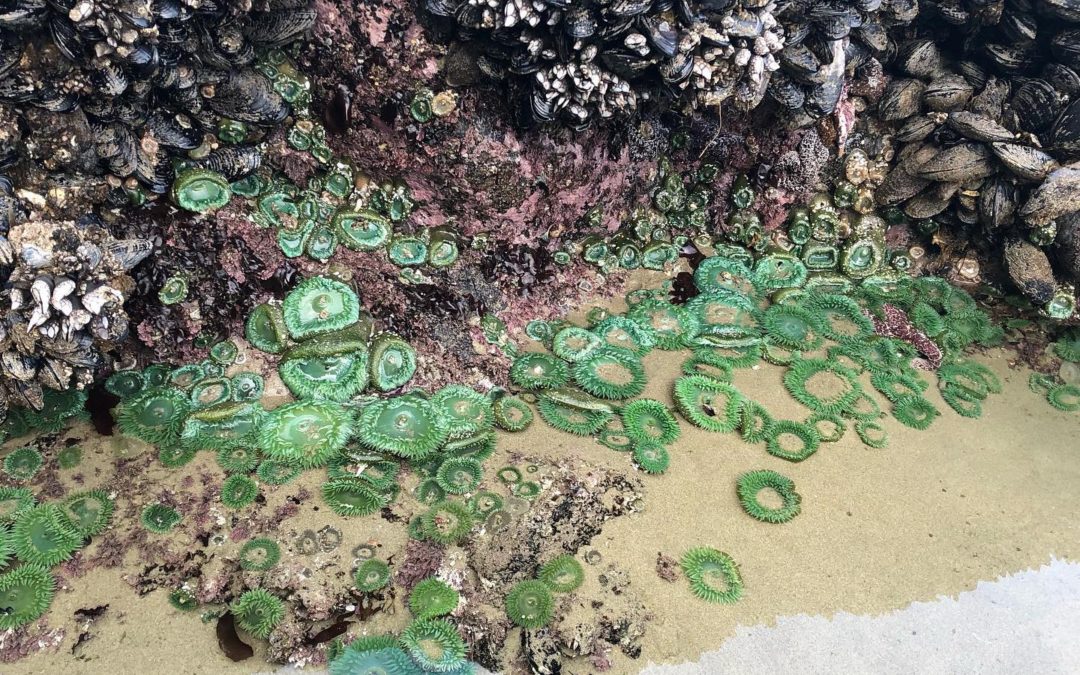Oregon’s coastline is amazingly beautiful. Many of our beaches are home to rocky intertidal habitats. These are rocky areas located at the edge of the ocean between the high and low tides. What makes rocky intertidal areas so interesting to explore are tide pools! A tide pool is a shallow pool of water left in low places along the shoreline. These pools are visible when the tide is low and covered with water when the tide is high. Many plants and animals live in tide pools which are found all around the world. Wherever there’s a rocky seashore, there are tide pools. Including here in Tillamook County!
Life in tide pools is dynamic and amazing. When you venture out to the rocky shore, look for layers of habitats. Check out the life living at the edge of the sand and then scan your eyes up along the rocks. The first thing you may notice is how much life is living in these areas! The rich diversity that can be found is astounding. Next, you will notice that the community of animals and plants change as you move from the wet, low areas to the higher (and drier) ones. The intertidal area is divided into different regions: the splash zone, high tide zone, mid tide zone, and low tide zone. Animals and plants living in the splash zone only need a spray of water to survive. Here you will find tiny acorn barnacles, limpets, and snails. This is the opposite of the low tide zone, a place that is typically under water except during the lowest tides. In these locations, you will find different algaes, sea slugs, sponges, and more. Maybe the most obvious break is between the low-tide zone and the mid-tide zone. The mid-tide zone is home to mussels, and there is a clear line that forms here. Mussel habitat is bound by the high tide zone, which is too dry, and the range of sea stars(a major predator) in the low tide zone.
When visiting the beach and tide pools, follow these easy steps to keep you, your group, and the plants and animals in these areas safe.
Know where to go! Do a little research to find out which beaches offer the best tide pools for your group. Not all tide pool areas are easy to get to. Some locations have tide pools in areas that get cut off as the water rises and starts to flood the beach during high tide. This can create a dangerous situation for you and your group.
Know when to go! Go during a nice low tide. When I go out with my family or take out groups to learn more about tide pools, I aim for 1 to 2 hours before the predicted negative low tide (-0.8 feet or lower). Check a tide book or use any of a number of great online tools to find out when the tide will be low on your favorite beach. Every location is different, but the lower the tide the better the experience. The best times to tide pool usually occur in the late spring and summer months.
Keep an eye on the ocean! Even when the tide is predicted to be very low, many things can change the water level on the beach. Local and offshore weather can affect how flooded the beach is. At any time, large waves can surprise you on the beach. Always face the ocean and watch out for sneaker waves.
Watch your step! Step carefully when exploring. The rocks are full of living plants and animals. Walk on bare sand or rocks when investigating the tide pools. Remember to protect yourself while exploring. Avoid bare feet, flips flops or shoes that easily come off. Opt for something sturdy with a closed toe and good tread. Remember, your feet will likely get wet.
Be gentle! I encourage people to explore and feel the tide pools but to touch gently using 1 or 2 fingers. Never poke or try to pull animals off the rock. This may hurt or kill the animal. Some animals are territorial and a rival may not be welcoming if you move them to a new pool.
A great way to learn more is to hook up with a local organization or agency. Explore Nature partners (like us – Friends of Netarts Bay WEBS) and Oregon State Parks offer great opportunities to learn about life in the rocky intertidal and how to safely explore. Audubon Society of Lincoln City (ASLC) and the North Coast Rocky Habitat Coalition (NCRHC) work to identify and conserve sensitive rocky shore areas for future generations. These groups offer great ways to discover more about the wonders of Oregon’s rocky shores! * alternate below
Animals and plants living in our tide pools have many interesting adaptations that help them survive. From strategies to help them not dry out to avoiding predators, the more you discover the more fascinating it gets! Explore, learn and take care of these special places.
There are many great print and online resources. Checkout a book from the library or any of these recommended sites:
- Friends of Netarts Bay WEBS – Select Marine Invertebrates – a great guide compiled by FriendsWEBS board member and marine biologist, Jim Young.
- LiMPETS Rocky Intertidal Field Guide
AUTHOR: Chrissy Smith, Director of Friends of Netarts Bay – Watershed, Estuary, Beach, and Sea (WEBS)
Photo Source: WEBS
For more local health and wellness information, follow Tillamook County Wellness on Facebook, Instagram and Twitter.

